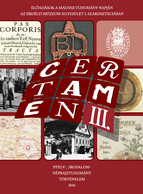Erdélyi magyarok a Szovjetunió kényszermunkatáboraiban
Hungarians from Transylvania in the Forced Labour Camps of the Soviet Union
Author(s): János Kristóf MurádinSubject(s): Military history, Social history, WW II and following years (1940 - 1949), Post-War period (1950 - 1989)
Published by: Erdélyi Múzeum-Egyesület
Keywords: deportation; lager; captivity; trauma; disease; hunger; homesickness; death
Summary/Abstract: The study outlines the nearly forgotten historical event of the capturing of the civilian people as prisoners by the Red Army, that was taking control over Northern Transylvania in the fall of 1944. This central, planned and well organized action extended all over the northern region of Transylvania, and it was aimed especially on Hungarians from Szeklerland, central Transylvania and Crișana (Partium). There were taken by force around 20 000 Hungarian men, among them 5000 from the capital city of Transylvania, Cluj (Kolozsvár). The age of the prisoners was between 16 and 55 years. They were deported to several forced labour camps from the Soviet Union. The time spent in captivity in most of the cases was 4 years, but sometimes it could take even 8-9 years. The camps of war prisoners were situated on the territory of Ucraine (for example: Mykolaiv), in Ural Mountains (Ufa, Asa, Magnitogorsk), in Crimean Peninsula (Sevastopol, Simferopol, Feodosia) and in the region of the Sea of Azov (Taganrog) etc. The prisoners had to work in different mines or at loggings in very hard conditions, in summers being engaged in agricultural works in nearby Soviet kolkhozes. As a result of their very hard work and of the acute lack of food and medicines, the prisoners became extremely extenuated. One third of themdied in captivity. This piece of our contemporary history was a taboo subject during the whole Communist era, a real change being brought only by the revolution of 1989. Our study is based mostly on papers and articles published in the last two decades, which deal with these tragic events, and tries to offer an overview on the discussed problem. The source material of the study consists of books, studies, essays, memoirs, published recollections, data and articles printed in contemporary press, as well as interviews with survivors made by the author.
Journal: Certamen
- Issue Year: 2016
- Issue No: III
- Page Range: 415-428
- Page Count: 14
- Language: Hungarian

